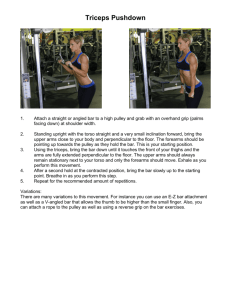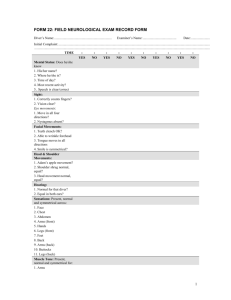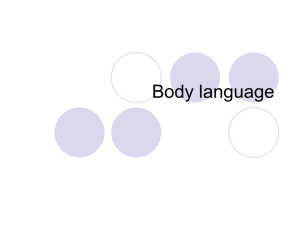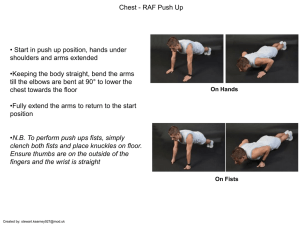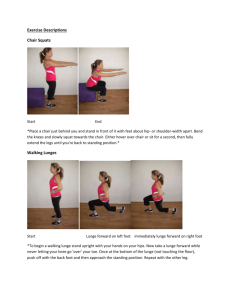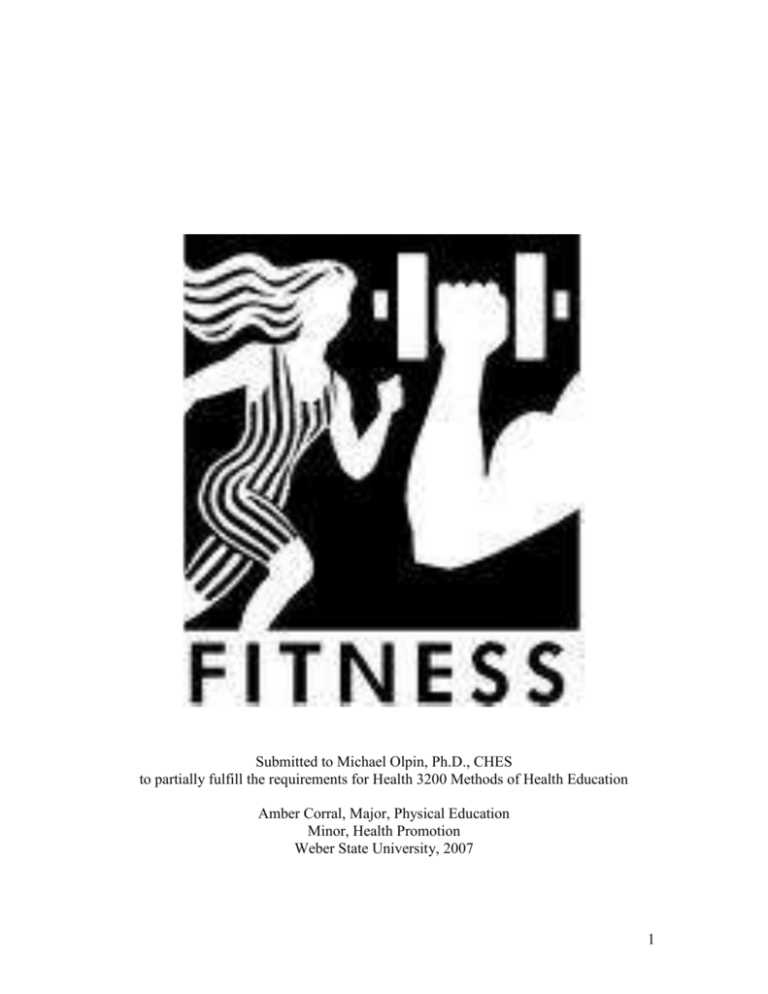
Submitted to Michael Olpin, Ph.D., CHES
to partially fulfill the requirements for Health 3200 Methods of Health Education
Amber Corral, Major, Physical Education
Minor, Health Promotion
Weber State University, 2007
1
Table of Contents
Introduction
Overview ...........................................................................................................................3
Statistics ...........................................................................................................................4
Cardio Vascular Exercise ..................................................................................................4
Lesson Plan I Abs and Thighs ...............................................................................................5
Stretches ........................................................................................................................5
Stretches Cont…...…………………………..............................................................6
Abdominal Workout ......................................................................................................6
Abdominal Workout Cont..............................................................................................7
Thigh and Buns Workout ...............................................................................................7
Thigh and Buns Workout Cont. ....................................................................................8
Cool Down ....................................................................................................................8
Evaluation and Summary ............................................................................................8
References ....................................................................................................................8
Lesson Plan II Biceps, Triceps, and Shoulders ......................................................................9
Warm up.......................................................................................................................9
Warm up Cont ..............................................................................................................9
Warm up Cont. .............................................................................................................10
Biceps ..........................................................................................................................10
Biceps Cont .................................................................................................................11
Triceps.........................................................................................................................11
Shoulders.....................................................................................................................12
Cool Down ..................................................................................................................12
Evaluation and Summary ............................................................................................12
Lesson Plan III Cardio Vascular ............................................................................................13
Warm up.....................................................................................................................13
Warm Up Cont ..........................................................................................................14
Jogging .....................................................................................................................14
Stationary Biking ....................................................................................................14
Stationary Biking Cont ............................................................................................15
Cool Dow………………………………………………………………………..15
Evaluation and Summary……………………………………………………15
References…………………………………………………………………….15
Stretching………………………………………………………………………………16
Article…………………………………………………………………………………..17
Article Cont………………………………………………………………………………18
Article Cont………………………………………………………………………………19
Medicine Ball Exercises…………………………………………………………………20
Stretches for Running……………………………………………………………………21
2
Introduction
Overview
More than 60% of adults don't get the recommended amount of regular physical activity.
Worse yet, 25% of all adults are not active at all! Nearly 50% of young people aged 1221 are not vigorously active on a regular basis. Only 19 % of all high school students are
physically active for 20 minutes or more in physical education classes every day during
the school week. When was the last time you took a moment and celebrated your body?
Not because it's well built or attractive by society's standards, but because it's an
impressive piece of functional art.
In this unit we will learn about physical fitness by performing a variety of activities. By
providing you with a few examples of workouts I hope that you will leave this unit with a
better understanding of fitness. I hope that you will take out of this unit a love for
activity and physical fitness.
http://www.myfit.ca/archives/viewanarticle.asp?table=fitness&ID=12
Did you know?
There are 1,440 minutes in every day. You should schedule 30 of them for
physical activity!
Regular exercise is a critical part of staying healthy.
People who are active live longer and feel better.
Exercise can help you maintain a healthy weight.
Exercise can delay or prevent diabetes, some cancers and heart
problems.
Stretching and weight training can also strengthen your body and improve
your fitness level.
Most adults need at least 30 minutes of moderate physical activity at least five
days per week. Examples include walking briskly, mowing the lawn, dancing,
swimming for recreation or bicycling.
http://www.nlm.nih.gov/medlineplus/exerciseandphysicalfitness.html
3
Exercise Keeps joints, tendons and ligaments flexible so it's easier to
move around
Exercise Reduces some of the effects of aging
Exercise Contributes to your mental well-being and helps treat depression
Exercise Helps relieve stress and anxiety
Exercise Increases your energy and endurance
Exercise Helps you sleep better Exercise Helps you maintain a normal
weight by increasing your metabolism (the rate you burn calories)
http://familydoctor.org/online/famdocen/home/healthy/physical/basics/059.printer
view.html
.
Cardiovascular Exercise
When it comes to reducing body fat cardiovascular exercise is a critical part of your
regime, however there four principles which we must follow if we are to be successful.
These can be summed up as FITT.
F
Frequency
I
Intensity
T
Time
T
Type
Cardiovascular exercise is any exercise that utilizes oxygen via the heart and lungs, in
other words any exercise that gets our heart rate up and increases our breathing.
Frequency - How many times we need to exercise in order to lose body fat. 3 times per
week is a good starting point for a beginner, but 4-5 times is definitely recommended.
Intensity - Refers to how hard we workout. Many of our cardiovascular machines
include heart rate monitors which measure how many times the heart beats per minute.
This is very important as working at an intensity that is too low will not produce the
desired results and an intensity that is too high will ensure you burn off glycogen stores
rather than body fat and may result in injury due to the excessive loads placed upon the
body.
Time - It is recommended by experts that you exercise for a minimum of 20 minutes in
order to start burning body fat. All our cardio exercise machines include consoles that
measure the time you have been exercising.
Type - The type of exercise we use is known as the 'mode' of exercise, it is important to
choose an exercise mode that allows you to exercise at a moderate intensity ideally for
twenty minutes or more. Such exercises include walking, jogging, cycling, rowing, crosscountry skiing, stepping and boxing to name but a few.
4
Lesson Plan 1
Abs, Thighs, and Buns
Goal
To help students understand the importance of physical fitness through performing a
variety of abs and thighs exercises.
Objectives
By the end of the period the students will be able to repeat three exercises for thighs and
threes exercise for abs.
By the end of the period the students will have participated in various abs and thighs
exercises.
By the end of the period the students will have shown respect for the equipment and other
students.
Target Audience
High School to College
Materials Needed
Mats
Dynabands
Medicine Balls
Music with up beat and slow songs
Introduction (3 Min)
Discuss different ways of working out. (I.E. Machines, Free weights, running, sports,
leisure activities.) Have the students help you out naming off a few. Eventually gear the
students toward aerobics. Stress that aerobics is something that is widely used in gyms
and classrooms today and that it is what we will be doing today.
Activity 1 Warm-UP (5 Min)
Spinal Twist (Pretzel): Muscles affected- internal oblique, external oblique, and spinal
erectors
1. Sitting with legs straight and upper body nearly vertical, place right foot on left
side of left knee.
5
2. Place back of left elbow on right side of right knee, which is now bent.
3. Place right palm on floor behind hips.
4. Push right knee to left with left elbow while turning g shoulders and head to the
right as far as possible. Try to look behind the back
5. Hold for 20 seconds
6. Repeat with left leg
Side bends with straight arms. Muscles affected- external oblique, latissimus dorsi, and
serratus anterior
1. Stand with feet shoulder width apart
2. Interlace the fingers with the palms facing each other
3. Reach upward with straight arms
4. Keeping arms straight, lean from waist to left side. Do not bend knees
5. Repeat to the left side
Butterfly: Muscles affected- Adductors and sartorious
1. Sitting with the upper body nearly vertical and legs straight, flex both knees as the
soles of the feet come together.
2. Pull feet toward the body
3. Place hand on feet and elbows on legs.
4. Pull torso slightly forward as elbows push legs down.
5. Hold for 20 seconds
Straddle (Spread Eagle): Muscles affected- gastronemius, hamstrings, spinal
erectors, adductors, and sartorius
1. Sit with the upper body nearly vertical and legs straight, and spread legs as far as
possible.
2. With right hand, grasp toes of right foot and pull on toes slightly, while pulling
chest toward right leg. Hold for 20 seconds
3. Release toes and relax foot.
4. Grasp ankle and continue to pull chest toward right leg.
5. Point toes away from body and continue to pull chest toward right leg.
6. Repeat process with left leg
7. Repeat process by grasping right toes with right hand and left toes with left hand.
Move the torso forward and toward the ground.
Toe Touch: Muscles affected-Hamstrings and lower back
1. Both feet together
2. Bend at the waist
3. Go as far as you can down attempting to touch your toes.
Activity 2 Abs Work Out (17 Min)
Lying with your back on the mat and your knees bent perform the following:
Regular sit ups: 3X8
Up and Pulse: 1X8
Military sit ups: 1X8
6
Up and Reach left: 2X8
Up and Reach right: 2X8
The following are performed while on or using the medicine ball:
With medicine ball: Up and Between 1X5
Ball Sit-Ups: 3X8
Ball Lateral Abs: 2X8 Both sides
Definitions:
Up and Pulse = Just as a regular sit up only you hold at the top for 4 seconds. (Up, 2, 3,
4, down Up, 2, 3, 4)
Military Sit Ups = Just as a regular sit up only you go half way up, all the way up, down,
all the way up and down.
(Up, Up, Down, UP, DOWN repeat)
Up and Reach Left = Just as a regular sit up only you reach out across your body to the
diagonal side. Then you repeat to the other side.
With Medicine Ball = Start lying on the floor with your legs and arms fully extended.
Place the medicine ball between your arms while still lying on the floor. Bring your legs
up and arms up with the ball in them making a V shape with your body. Exchange the
ball in between your legs. Come back down to the starting position without letting your
arms and legs touch the ground. The ball should now be between your legs. Repeat.
Ball Sit Ups: Incline position with arms behind your head, sitting on the ball. Curl your
trunk up and return to starting position.
Ball Lateral Abs: Slide lying position with inside leg bent and outside leg straight
supporting you. One arm should be across the body and on the ball stabilizing while the
other is behind the head. Laterally flex the trunk pulling the ribcage down toward the hip.
Activity 3 Thigh Work Out (17 Min)
The following are performed while lying on your mat:
Side leg lifts: 2X8 both sides
Half way up and push: 3X8 both sides
U up and back: 2X8 both sides
Parallel Pulse: 3X8 both sides
The following are performed while standing with your Dynaband around your
ankles:
NOTE: It is important to stress that the students don’t allow slack in their bands.
Keep them tight!
Penguin: 3X8
Side touch: 2X8
Push Backs: 2X8
Walk up and Back: 2X8
7
Definitions:
Penguin = With the Dynaband tied around your ankles you push your feet out one at a
time repeating it over and over again.
Side Touch = With the Dynaband tied around your ankles take your right foot and touch
it on the ground further out and bring it back in. Repeat with your left foot.
Push Backs = With the Dynaband around your ankles take your right foot and kick it
behind you. Bring it back and repeat using the left foot.
Activity 4 Cool Down (5 Min)
Have the students lye down on their mats and stretch wall to wall. This means to
put your legs straight out and your arms straight out and stretch your body.
Bring both legs in bending them and wrap your arms around them giving yourself
a hug.
Let your legs drop to one side and put your hand flat on the ground in a “T”
position letting your head fall to the opposite side.
Side up on the mat in a “Butterfly” stretch
Stretch out one leg straight in front of you and bend the other one up and over
putting your heel on the ground. Bring your opposite elbow of the foot around and
pull your leg in. Repeat with the other leg
Evaluation and Summary (3 Min)
Bring the students in and discuss how the lesson went. Discuss why it is important to
warm up and cool down when working out. Call on 6 different students and have each
student verbal tell you one exercise for the thigh or abs.
References
You Can Be An Aerobics Instructor, Brenda Davis
8
Lesson Plan 2
Triceps, Biceps, and Shoulders
Goal
To help students understand the importance of physical fitness through performing a
variety of bicep, triceps, and shoulder exercises.
Objectives
By the end of the period the students will be able to demonstrate one exercise for each
triceps, biceps, and shoulders.
By the end of the period the students will have performed three sets of each exercise for
today’s lesson.
By the end of the period the students will have shown respect for other students.
Target Audience
High School to College
Materials Needed
1 set of 3lb weights for each student (Also a couple 5lbs in case 3lb is too light)
Music
Introduction (3 Min)
Discuss briefly with the students where the triceps, biceps, and shoulders are located
within the body. Talk about the importance of working all the muscles in the body. Also
talk about the importance of warming up and cooling down. Tell them that we need to
gradually engage our muscles. Stretching prior to and after exercise prevents injury. Let
the students know that today we will continue our fitness unit by performing some
triceps, biceps, and shoulders.
Activity 1Warm Up (6 Min):
Behind-Neck Stretch: Muscles Affected- Triceps and Latissimus dorsi
1.
2.
3.
4.
Standing, flex right arm and rise elbow above the head.
Reach the right hand down toward the left scapula.
Grasp right elbow with left hand.
Pull elbow with left hand.
9
5. Hold for 20 seconds
6. Repeat with left arm
Straight Arms Behind Back: Muscles Affected- Deltoids and Pectoralis major
1.
2.
3.
4.
5.
6.
Standing, place both arms behind the back.
Interlock finger with palms facing each other.
Straighten arms fully.
Slowly raise the straight arms.
Hold for 20 seconds.
Keep head upright and neck relaxed
Cross Arm in Front of Chest: Muscles Affected-Latissimus dorsi and tres major
1. Stand with right arm slightly flexed and adducted across the chest.
2. Grasp the upper arm just above the elbow, placing the left hand on the posterior
side of the upper arm.
3. Pull the right arm across the chest and toward the left with the left hand.
4. Hold for 20 seconds.
5. Repeat with the left arm.
Side bends with straight arms. Muscles affected- external oblique, latissimus dorsi, and
serratus anterior
1. Stand with feet shoulder width apart
2. Interlace the fingers with the palms facing each other
3. Reach upward with straight arms
4. Keeping arms straight, lean from waist to left side. Do not bend knees
5. Repeat to the left side
Seated lean-Back: Muscles Affected- Deltoid and pectoralis major
1. Sitting with legs straight and arms extended place palms on the floor about 1 foot
behind the hips.
2. Point fingers away from the body.
3. Slide hands backward and lean backward.
4. Hold for 20 seconds.
Activity 2 (11 Min):
The following exercises are performed while holding either 3 or 5lb weights:
BICEPS
Bicep Curls 4X8
2 counts Bicep Curls 3X8
Up and Pulse 4X8
BICEPS OUT TO THE SIDE
Bicep Curls Out 4x8
2 counts Bicep Curls 3X8
10
Up and Pulse 4X8
Definitions:
2 Count Bicep Curls: Performed just as regular curls except you go half way the all the
way up and then back to half then all the way down. (Half, All, Half, Down)
Up and Pulse: Just as a curl only you hold at the top for 4 seconds. (Up, 2, 3, 4, Down
Up, 2, 3, 4)
Bicep Curls Out- Performed just as regular curls except instead of doing in straight out in
front of you, you go out toward the walls. (In the frontal plan)
Activity 3 (11 Min):
The following exercises are performed while holding either 3 or 5lb weights:
TRICEPS: This section is performed with your left foot forward and the weight in your
right hand. The right hand should be in a position similar to the “Left hand Turn Signal.”
After you do each exercise you then switch everything and do the exercises on the
opposite side.
Triceps Back: 4x8 Both Sides
2 Count Triceps Back 3x8 Both Sides
Up and Pulse 4x8 Both Sides
Definitions:
Triceps Back: Start out in the “Left hand turn” position and then extend the arm back
behind you.
2 Count Triceps Back: Performed just as regular triceps except you go half way the all
the way up and then back to half then all the way down. (Half, All, Half, Down)
Up and Pulse: Just as a triceps back only you hold at the top for 4 seconds. (Up, 2, 3, 4,
Down Up, 2, 3, 4)
TRICEPS BEHIND THE HEAD: This section is performed with your legs shoulder
width apart and your right arm with the weight and behind the head. You then extend it
straight up to the ceiling.
Triceps Up: 4X8 Both Sides
2 Count Triceps up 3x8 Both Sides
Up and Pulse 4x8 Both Sides
Both weights and Arms up 4x8
Definitions:
Triceps Up: Start with the weight behind the head and extend up to the ceiling.
2 Count Triceps up: Performed just as regular triceps up except you go half way the all
the way up and then back to half then all the way down. (Half, All, Half, Down)
Up and Pulse: Just as a triceps up only you hold at the top for 4 seconds. (Up, 2, 3, 4,
Down Up, 2, 3, 4)
11
Both weights and Arms up: With both weights together grasp them and put both hands
behind the head. Bring the weight up and down.
Activity 4 Shoulder (11 Min)
The following exercises are performed while standing, with one weight in each hand, and
arms to the sides of the body.
Out and Back Down 3x8
2 Count Out and Back Down 3x8
Out and pulse 2x8
Out and Hold 3x 20 seconds each
Definitions
Out and Back Down- Start with arms to the side and slowly bring them up until they are
straight out and then back down.
2 Count Out and Back Down.: Performed just as regular Out and Back Down up except
you go half way the all the way up and then back to half then all the way down. (Half,
All, Half, Down)
Up and Pulse: Just as regular Out and Back Down only you hold at the top for 4 seconds.
(Up, 2, 3, 4, Down Up, 2, 3, 4)
Out and Hold- Just and a regular out and back down only you just raise your arms up and
keep them up for 20 straight seconds.
Activity 5 Cool Down (6 Min)
Have the students spread out in the learning environment and perform the following
stretches. The same ones done in the warm up.
Behind-Neck Stretch
Straight Arms Behind Back
Cross Arm in Front of Chest
Side bends Seated lean
Evaluation and Summary (3 Min)
Bring the students in and discuss how they felt the lesson went.
References
You Can Be An Aerobics Instructor, Brenda Davis
12
Lesson Plan 3
Goal
To help students understand the importance of physical fitness through performing a
variety cardio vascular exercises.
Objectives
By the end of the period the students will have participated in 30 minutes of cardio
vascular activity.
By the end of the period the students will be able to name 4 cardio vascular exercises.
By the end of the period the students will have shown positive encourage to others by
cheering on at least three other students.
Target Audience
High School to College
Materials Needed
Introduction (4 Min.):
Start off by explaining that we have over 600 muscles in our bodies, the heart being one
of them. Stress that the heart is the most important muscle in our bodies. Have the
students help you come up with as many cardio vascular exercises as they can. (Exercises
that work the heart muscle) (I.e. running, biking, rowing) Explain that today’s lesson will
be all about working our heart muscle.
Activity 1Warm Up (7 Min):
Hamstring Stretch: Muscles Affected- Hamstring
1.
2.
3.
4.
Place feet together
Slowly bend at the waist reaching for the toes
Keep your head down
Hold for 30 seconds
13
Quadriceps Stretch: Muscles Affected- Quadriceps
1.
2.
3.
4.
5.
6.
Balance on your right foot.
Raise your left foot towards you Glutes
Keep your knee facing the ground
Grab your left foot with your left hand and pull towards the Glutes
Hold for 30 seconds
Repeat with the right leg.
Straddle (Spread Eagle): Muscles affected- gastronemius, hamstrings, spinal
erectors, adductors, and sartorius
1. Sit with the upper body nearly vertical and legs straight, and spread legs as far as
possible.
2. With right hand, grasp toes of right foot and pull on toes slightly, while pulling
chest toward right leg. Hold for 20 seconds
3. Release toes and relax foot.
4. Grasp ankle and continue to pull chest toward right leg.
5. Point toes away from body and continue to pull chest toward right leg.
6. Repeat process with left leg
7. Repeat process by grasping right toes with right hand and left toes with left hand.
Move the torso forward and toward the ground.
Calf Stretch: Muscles Affected- gastronemius
1.
2.
3.
4.
5.
Find an open space on a wall.
Place left foot back about 2 feet, making sure the heel is planted
Slightly bend the right knee, placing pressure on the left calf
Hold for 30 seconds
Repeat with the opposite foot
Activity 2 Jogging (14 Min):
Start off by telling the students that when they pass on another they need to call out,
“Left” or “Right” indicating which side they will be passing on. Also remind them that
they need to say 3 different words of encouragement to 3 different students throughout
today’s lesson. Explain to the students that they will start off when the whistle is blown
once. When they hear a 2 toot whistle blow they are to stop jogging and start speed
walking. This is done by walking at a fast pace and pumping the arms.
Have the students jog at there own pace around the track for 6 minutes. After the 6
minutes has past you blow the whistle twice and have them walk for 1 minute. When that
minute is up you blow your whistle again once and they will begin jogging again. Do this
for a total of 14 minutes.
Activity 3 Stationary Biking (14 Min)
Remind the students that they need to say 3 different words of encouragement to 3
different students throughout today’s lesson. Explain to the students that they will start
14
off when the whistle is blown once. When they hear a 2 toot whistle blow they are to
pedal at a slower pace.
Have the students stand next to a bike. Explain that the seat of the bike needs to be at
waist level. Have them adjust it accordingly. When the whistle blows they are to start
pedaling at a fast pace. After the 6 minutes has past you blow the whistle twice and have
them slow for 1 minute. When that minute is up you blow your whistle again once and
they will begin to pedal at a fast speed. Do this for a total of 14 minutes.
Activity 4 Cool Down (6 Min)
Have the students walk around the tack once. When they return have them spread out in
the learning environment and perform ALL the stretches done in the warm up as well as:
Butterfly: Muscles affected- Adductors and sartorious
1. Sitting with the upper body nearly vertical and legs straight, flex both knees as the
soles of the feet come together.
2. Pull feet toward the body
3. Place hand on feet and elbows on legs.
4. Pull torso slightly forward as elbows push legs down.
5. Hold for 20 seconds
Evaluation and Summary (5Min)
Bring the students in and discuss today’s lesson. Call on 4 different students and ask each
one to tell you an exercise that a person could do to work the heart muscle. Tell the
students that in order to keep their heart muscle in shape you need to keep working it just
like you do any other part of the body.
References
Amber Corral
You Can Be An Aerobics Instructor, Brenda Davis
15
16
Original Article:
http://www.nlm.nih.gov/medlineplus/exerciseandphysicalfitness.html
Exercise: 7 benefits of regular
physical activity
Want to feel better, have more energy and perhaps even live longer? Look no
further than old-fashioned exercise.
The merits of exercise — from preventing chronic health conditions to boosting
confidence and self-esteem — are hard to ignore. And the benefits are yours for
the taking, regardless of age, sex or physical ability. Need more convincing?
Check out seven specific ways exercise can improve your life.
1. Exercise improves your mood.
Need to blow off some steam after a stressful day? A workout at the gym or a
brisk 30-minute walk can help you calm down.
Exercise stimulates various brain chemicals, which may leave you feeling
happier and more relaxed than you were before you worked out. You'll also look
better and feel better when you exercise regularly, which can boost your
confidence and improve your self-esteem. Exercise even reduces feelings of
depression and anxiety.
2. Exercise combats chronic diseases.
Worried about heart disease? Hoping to prevent osteoporosis? Regular exercise
might be the ticket.
Regular exercise can help you prevent — or manage — high blood pressure.
Your cholesterol will benefit, too. Regular exercise boosts high-density lipoprotein
(HDL), or "good," cholesterol while decreasing low-density lipoprotein (LDL), or
"bad," cholesterol. This one-two punch keeps your blood flowing smoothly by
lowering the buildup of plaques in your arteries.
And there's more. Regular exercise can help you prevent type 2 diabetes,
osteoporosis and certain types of cancer.
3. Exercise helps you manage your weight.
17
Want to drop those excess pounds? Trade some couch time for walking or other
physical activities.
This one's a no-brainer. When you exercise, you burn calories. The more
intensely you exercise, the more calories you burn — and the easier it is to keep
your weight under control. You don't even need to set aside major chunks of time
for working out. Take the stairs instead of the elevator. Walk during your lunch
break. Do jumping jacks during commercials. Better yet, turn off the TV and take
a brisk walk. Dedicated workouts are great, but activity you accumulate
throughout the day helps you burn calories, too.
4. Exercise strengthens your heart and lungs.
Winded by grocery shopping or household chores? Don't throw in the towel.
Regular exercise can leave you breathing easier.
Exercise delivers oxygen and nutrients to your tissues. In fact, regular exercise
helps your entire cardiovascular system — the circulation of blood through your
heart and blood vessels — work more efficiently. Big deal? You bet! When your
heart and lungs work more efficiently, you'll have more energy to do the things
you enjoy.
5. Exercise promotes better sleep.
Struggling to fall asleep? Or stay asleep? It might help to boost your physical
activity during the day.
A good night's sleep can improve your concentration, productivity and mood.
And, you guessed it; exercise is sometimes the key to better sleep. Regular
exercise can help you fall asleep faster and deepen your sleep. The timing is up
to you — but if you're having trouble sleeping, you might want to try late
afternoon workouts. The natural dip in body temperature five to six hours after
you exercise might help you fall asleep.
6. Exercise can put the spark back into your sex life.
Are you too tired to have sex? Or feeling too out of shape to enjoy physical
intimacy? Exercise to the rescue.
Regular exercise can leave you feeling energized and looking better, which may
have a positive effect on your sex life. But there's more to it than that. Exercise
improves your circulation, which can lead to more satisfying sex. And men who
exercise regularly are less likely to have problems with erectile dysfunction than
are men who don't exercise, especially as they get older.
7. Exercise can be — gasp — fun!
18
Wondering what to do on a Saturday afternoon? Looking for an activity that suits
the entire family? Get physical!
Exercise doesn't have to be drudgery. Take a ballroom dancing class. Check out
a local climbing wall or hiking trail. Push your kids on the swings or climb with
them on the jungle gym. Plan a neighborhood kickball or touch football game.
Find an activity you enjoy, and go for it. If you get bored, try something new. If
you're moving, it counts!
Are you convinced? Good. Start reaping the benefits of physical activity today!
By Mayo Clinic Staff
Jul 26, 2007
© 1998-2007 Mayo Foundation for Medical Education and Research (MFMER).
All rights reserved. A single copy of these materials may be reprinted for
noncommercial personal use only. "Mayo," "Mayo Clinic," "MayoClinic.com,"
"Embody Health," "Reliable tools for healthier lives," "Enhance your life," and the
triple-shield Mayo Clinic logo are trademarks of Mayo Foundation for Medical
Education and Research.
HQ01676
19
Here are some other great examples of some Abdominal exercises you
can do using a medicine ball.
Squat and reach
Squat and reach with the fitness ball:
Hold the ball in front of you and bend
your knees. Keep your back straight and
your arms parallel to the floor (A). Don't let
your knees extend beyond your feet.
Tighten your abdominal muscles.
Rotate your trunk and reach with the ball
toward your left (B). Hold for three deep
breaths.
Return to the start position and repeat to
the right.
Vary the exercise by holding the ball in a
downward position (C) or an upward
position (D).
.
Bridge with heel dig
When you're comfortable with the bridge, add a heel dig:
Lie on your back with your legs resting on top of the ball. Raise
your hips and buttocks off the floor into a bridge (A).
Tighten your abdominal muscles.
Keep your hips off the floor while you pull the ball closer to your
buttocks with your feet (B). Dig your heels into the ball for traction and
to engage the muscles along the back of your thighs (hamstrings).
Hold for three deep breaths.
Return to the start position and repeat
http://www.mayoclinic.com/health/weight-training/SM00041&slide=9
20
Here are some great examples of some stretches that should be
performed prior to running. They can also be used any time prior to or
after working out.
http://www.rice.edu/~jenky/sports/stretching.html
21



